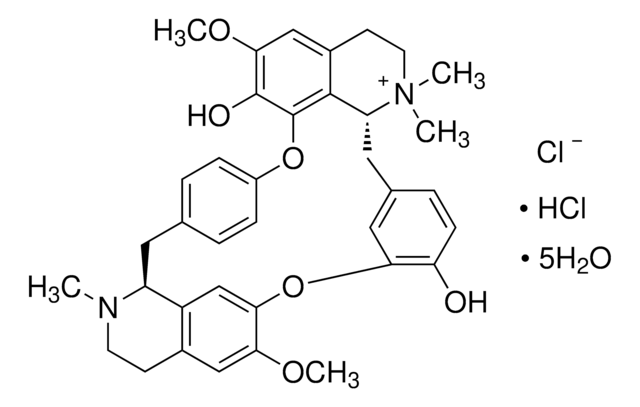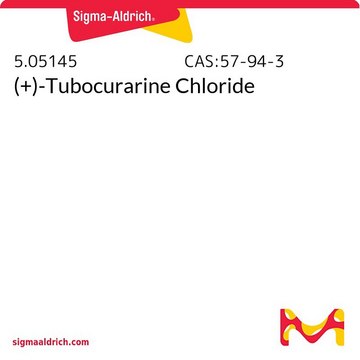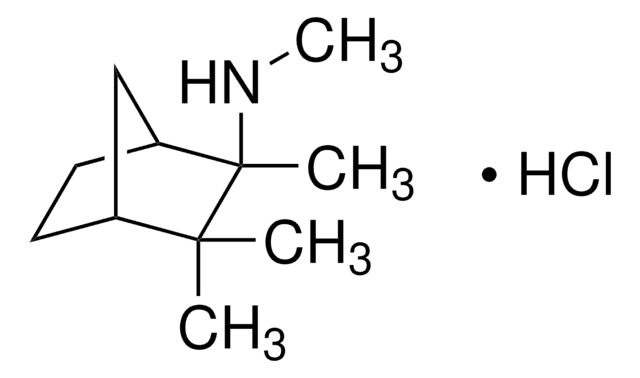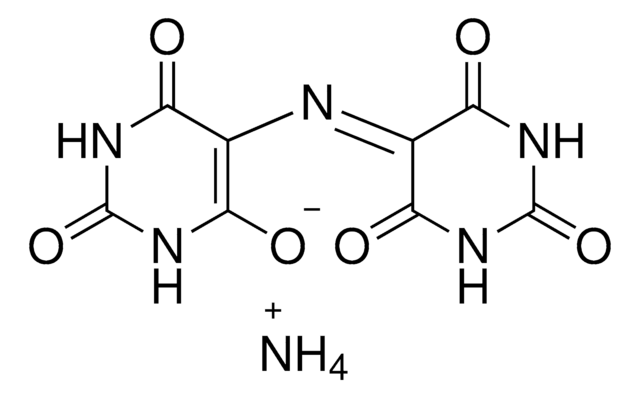A0325200
Alcuronium chloride
European Pharmacopoeia (EP) Reference Standard
Sinônimo(s):
N,N′-Diallylnortoxiferinium dichloride
About This Item
Produtos recomendados
grau
pharmaceutical primary standard
família API
alcuronium
fabricante/nome comercial
EDQM
aplicação(ões)
pharmaceutical (small molecule)
Formato
neat
temperatura de armazenamento
−20°C
cadeia de caracteres SMILES
[Cl-].[Cl-].[N+]21([C@@H]3C4([C@H]5N(c%11c4cccc%11)\C=C6/[C@@H]7N(c8c(cccc8)C97[C@H]%10[N+](CC9)(C\C(=C\CO)\C/6C%10)CC=C)\C=C/5\C(C3)\C(=C/CO)\C2)CC1)CC=C
InChI
1S/C44H50N4O2.2ClH/c1-3-17-47-19-15-43-35-9-5-7-11-37(35)45-26-34-32-24-40-44(16-20-48(40,18-4-2)28-30(32)14-22-50)36-10-6-8-12-38(36)46(42(34)44)25-33(41(43)45)31(23-39(43)47)29(27-47)13-21-49;;/h3-14,25-26,31-32,39-42,49-50H,1-2,15-24,27-28H2;2*1H/q+2;;/p-2/b29-13-,30-14-,33-25-,34-26-;;/t31?,32?,39-,40-,41-,42-,43?,44?,47?,48?;;/m0../s1
chave InChI
CPYGBGOXCJJJGC-ZHNYPADJSA-L
Categorias relacionadas
Descrição geral
For further information and support please go to the website of the issuing Pharmacopoeia.
Aplicação
Embalagem
Outras notas
Palavra indicadora
Danger
Frases de perigo
Declarações de precaução
Classificações de perigo
Acute Tox. 2 Oral
Código de classe de armazenamento
6.1A - Combustible acute toxic Cat. 1 and 2 / very toxic hazardous materials
Classe de risco de água (WGK)
WGK 3
Ponto de fulgor (°F)
Not applicable
Ponto de fulgor (°C)
Not applicable
Escolha uma das versões mais recentes:
Certificados de análise (COA)
It looks like we've run into a problem, but you can still download Certificates of Analysis from our Documentos section.
Se precisar de ajuda, entre em contato Atendimento ao cliente
Já possui este produto?
Encontre a documentação dos produtos que você adquiriu recentemente na biblioteca de documentos.
Nossa equipe de cientistas tem experiência em todas as áreas de pesquisa, incluindo Life Sciences, ciência de materiais, síntese química, cromatografia, química analítica e muitas outras.
Entre em contato com a assistência técnica






